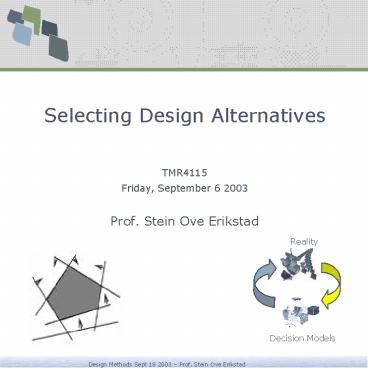Selecting Design Alternatives - PowerPoint PPT Presentation
1 / 20
Title:
Selecting Design Alternatives
Description:
X1 - Max. service speed. X2 - Motion behaviour. X3 - Total annual cost. Attribute values: ... paradox, Lotto, etc.), or not very CONSEQUENT (e.g. Lotto vs. ... – PowerPoint PPT presentation
Number of Views:75
Avg rating:3.0/5.0
Title: Selecting Design Alternatives
1
Selecting Design Alternatives
- TMR4115
- Friday, September 6 2003
- Prof. Stein Ove Erikstad
Reality
Decision Models
2
Selection problemsExample
- You work as a design engineer, and you are given
the task of designing a high speed vessel for a
particular route. Several alternative vessel
concepts are relevant, catamaran, SES, SWATH,
foil-cat. How can you decide which one is the
best conceptual solution?
3
?
4
Selection problemsExample 2
- You work in the transport division of Statoil.
You have just received more than 100 offers for
shuttle tankers for 10 years contracts between
Statfjord and Mongstad. - The offers contain vessels with different cargo
capacity, service speed, quality, age and price.
How can you rationally and efficiently select
the best offer?
5
Related to the design process
Problem statement
6
Classification of selection problems
1
3
1-dimensional
1-dimensional
No uncertainty
Uncertainty
4
2
Multi- dimensional
Multi- dimensional
No uncertainty
Uncertainty
7
Examples
- Your task is to select the main machinery
configuration for the vessel , and you have five
different alternatives before you. - Your objective is lowest weight. Only one
criteria that can be determined with no
uncertainty - Your objective is the best combination of cost,
weight and specific fuel consumption i.e.
multiple criteria which can be determined with (a
reasonable degree of) certainty
8
Examples, continued...
- 3. You want the solution that will give you the
lowest lifecycle maintenance cost, i.e. one
criteria with an uncertain value - 4. You want the solution with is preferable
taking price, weight, maintenance cost and
lifetime into consideration i.e.multiple
criterie with (at least some) uncertain values
9
Core concepts and notation
- Decision problem
- We must select a conceptual solution for a high
speed passenger vessel - Decision alternatives
- A - SES
- B - Catamaran
- C - FoilCat
- Attributes
- X1 - Max. service speed
- X2 - Motion behaviour
- X3 - Total annual cost
- Attribute values
- xA - (42, good, 8) (knots,
, mEUR) - xB - (34, medium, 5)
- xC - (48, excellent, 10)
10
Objective and objective hierarchy
- Preferable features
- 1. Complete cover all relevant aspects
- 2. Operational measurable and relevant criteria
- 3. Decomposable splitting/grouping possible
- 4. Non-redundant avoid counting some features
twice - 5. As small as possible
11
Objective hierarchy - example
12
Objective hierarchyHigh speed vessel example
Max lifecycle profit
13
Pareto
Dominans B is dominated by A D is dominated by
C G is not dominated
- Pareto-optimal set
- The set of non-dominated solution form a
Pareto-optimal set
14
The form of the value function
vi(xi)
vi(xi)
xi
xi
vi(xi)
vi(xi)
xi
xi
15
One-dimensional value function v i(x i)
- 1. Determine scale
- 2. Normalise
- 3. Determine form of function
16
Example
1
.
Determine scale
3. Determine form of function
min
Lower limit
x
27
kn
v
max
Upper limit
x
33
kn
1.0
v
2.
Normalize value function
v
(
27
)
0
.
0
v
v
(
33
)
1
.
0
0.0
v
33
27
17
The Assumption of an additiv value function
Examples of dependencies between the attributes
where
X1 max speed X2 motion behaviour X3 - total
annual cost
i.e.
we are willing to accept high annual cost for a
vessel with a high service speed IF the motion
characteristics are good. If, on the contrary,
the motion characteristics are bad, we are not
able to exploit the speed potential, and thus not
willing to pay much for a high max service speed.
18
Practical approaches to selection problems
- 1) Determine an objective hierarchy with
corresponding attributes - 2) Determine weights for each attribute, such
that S?i 1 - 3) Determine upper and lower limits for each
attribute, and give these the values 1.0 and 0.0,
respectively. Choose the form of the value
function default is linear. - 4) For each attribute Evaluate the different
alternatives, use the value function to determine
the value - 5) Calculate for each
alternative. Choose the alternative with the
highest value.
19
Decisions under uncertainty
- Types of uncertainty None, known, full.
- Risk concepts (Risk Probability
Consequence). Risk aversion/preference. - Rationality We ACT lite rasjonelt (eks. St.
Petersburg paradox, Lotto, etc.), or not very
CONSEQUENT (e.g. Lotto vs. bonds, stocks). Risk
premium. - Utility structures under uncertainty Minmax -
expected value - Problems by such calculations Moral model
related
20
Warning
- The main purpose here has been to discuss a
RATIONAL PLATFORM for decision-making NOT to
give a recipe for how such decision SHOULD be
made - The most important result from this process is
not a definite answer but as a documentation
of the process leading to the decision































